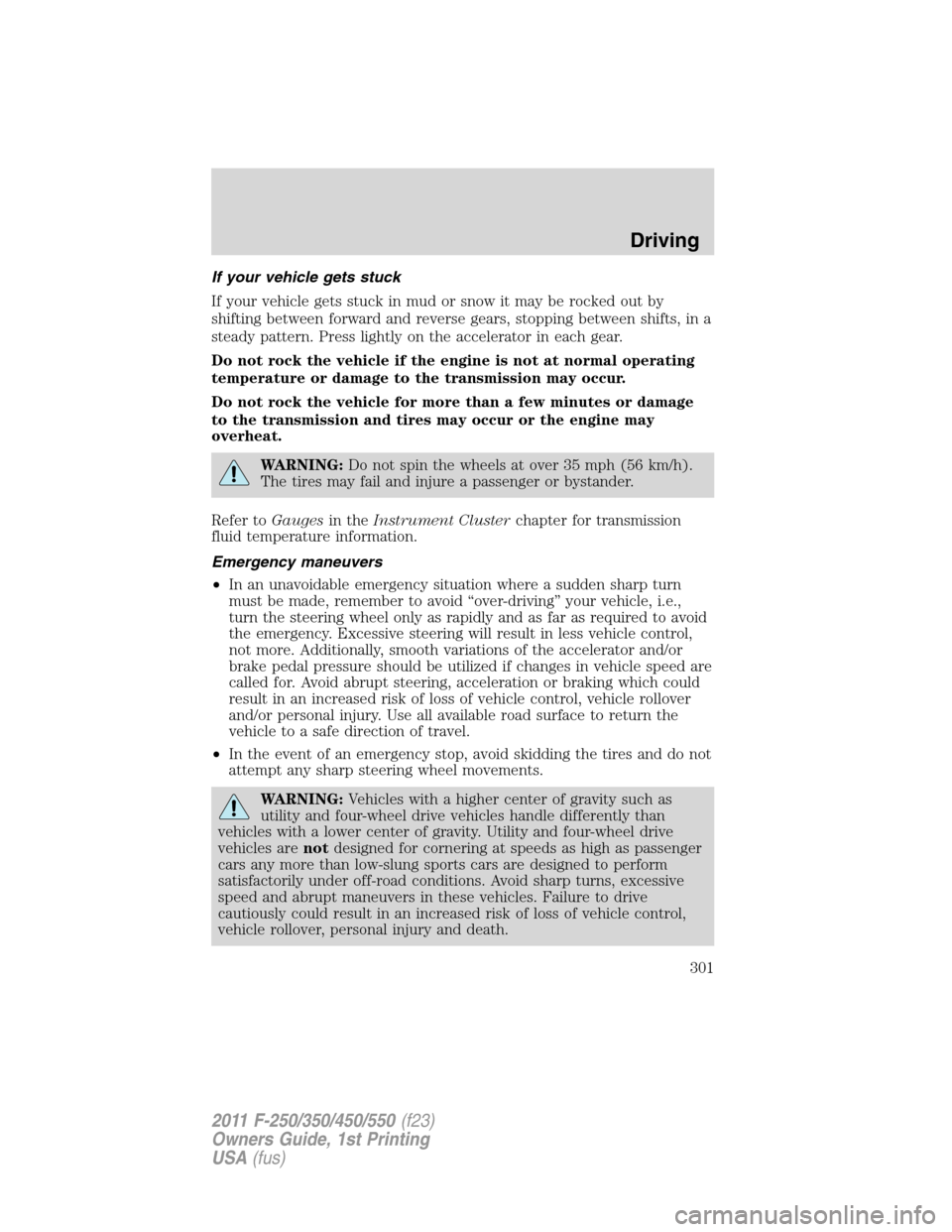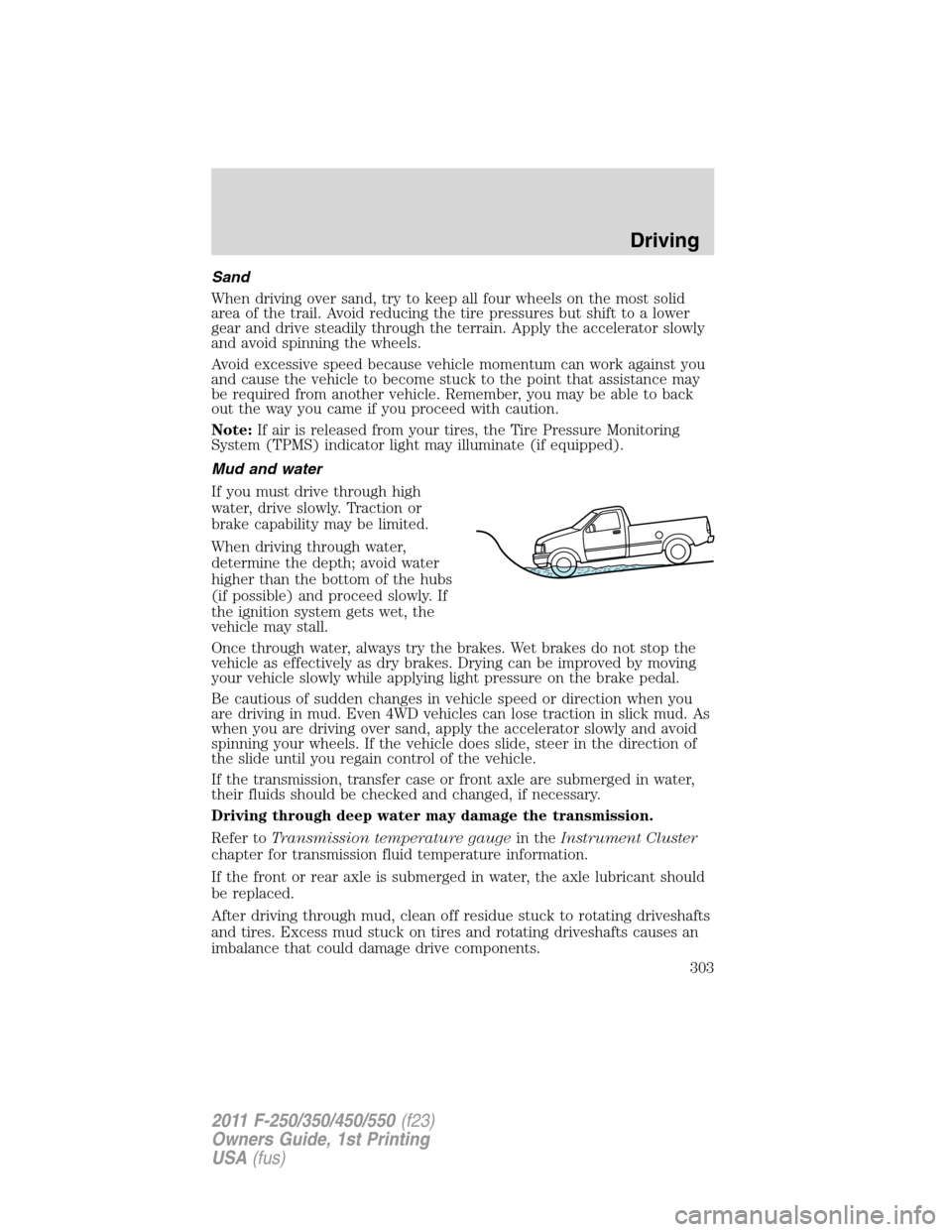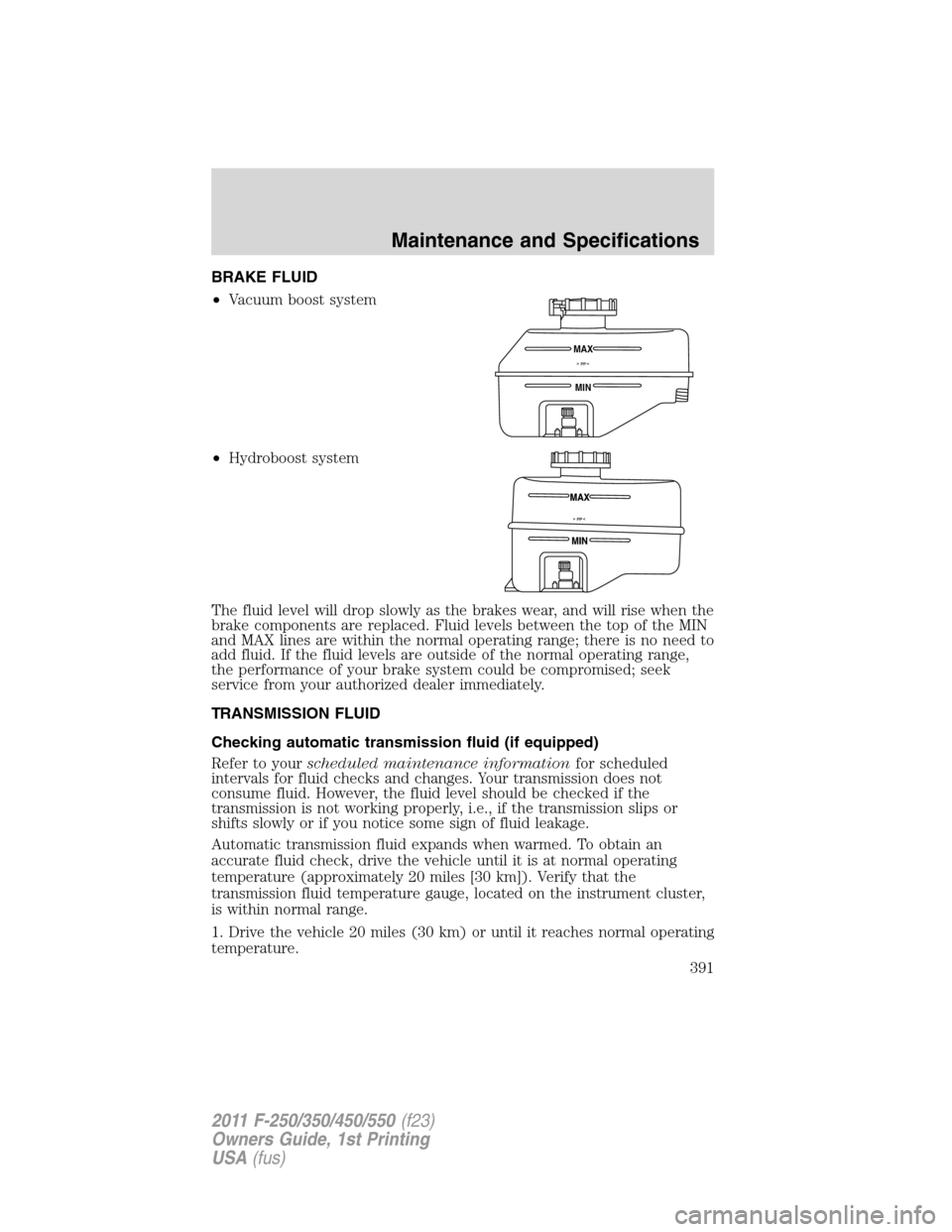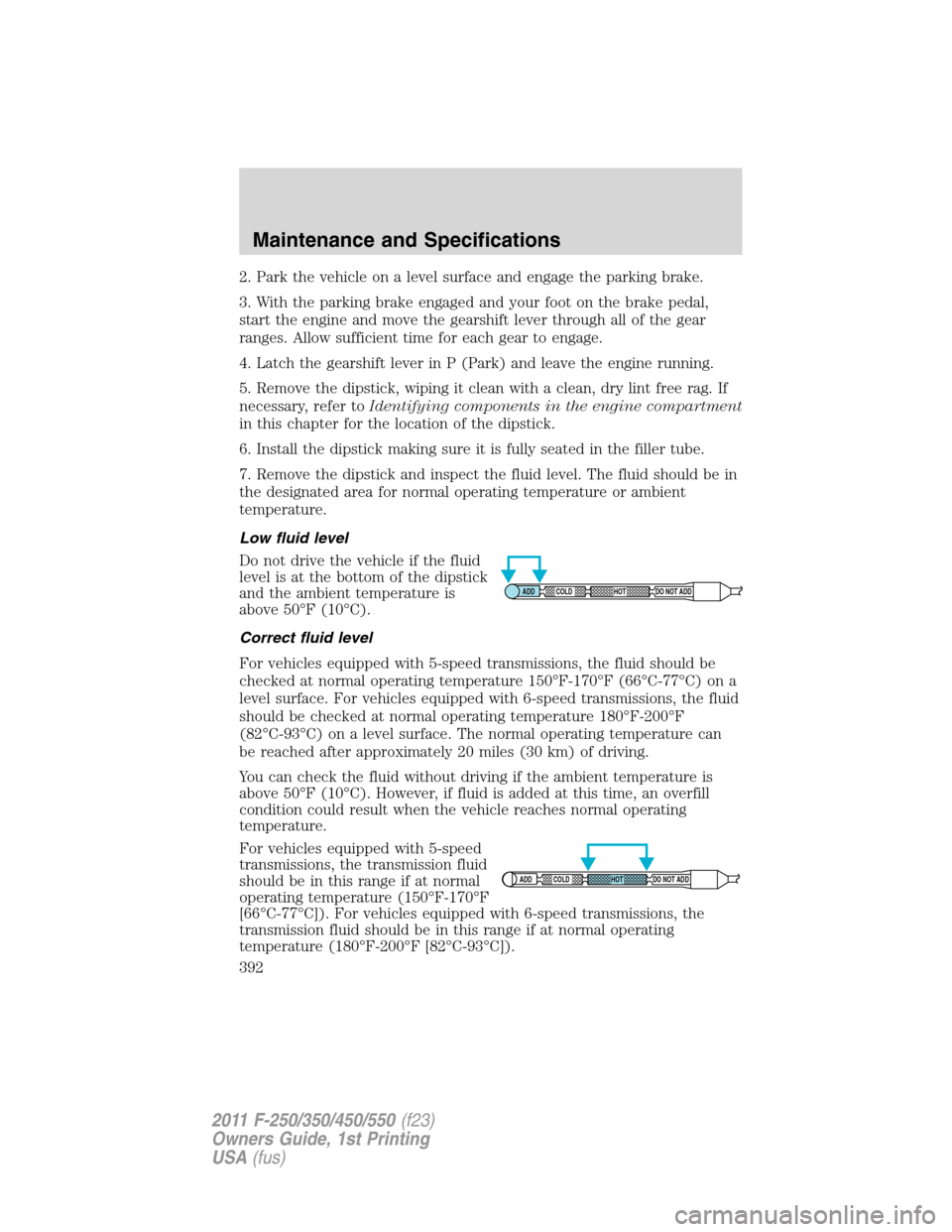Page 301 of 441

If your vehicle gets stuck
If your vehicle gets stuck in mud or snow it may be rocked out by
shifting between forward and reverse gears, stopping between shifts, in a
steady pattern. Press lightly on the accelerator in each gear.
Do not rock the vehicle if the engine is not at normal operating
temperature or damage to the transmission may occur.
Do not rock the vehicle for more than a few minutes or damage
to the transmission and tires may occur or the engine may
overheat.
WARNING:Do not spin the wheels at over 35 mph (56 km/h).
The tires may fail and injure a passenger or bystander.
Refer toGaugesin theInstrument Clusterchapter for transmission
fluid temperature information.
Emergency maneuvers
•In an unavoidable emergency situation where a sudden sharp turn
must be made, remember to avoid “over-driving” your vehicle, i.e.,
turn the steering wheel only as rapidly and as far as required to avoid
the emergency. Excessive steering will result in less vehicle control,
not more. Additionally, smooth variations of the accelerator and/or
brake pedal pressure should be utilized if changes in vehicle speed are
called for. Avoid abrupt steering, acceleration or braking which could
result in an increased risk of loss of vehicle control, vehicle rollover
and/or personal injury. Use all available road surface to return the
vehicle to a safe direction of travel.
•In the event of an emergency stop, avoid skidding the tires and do not
attempt any sharp steering wheel movements.
WARNING:Vehicles with a higher center of gravity such as
utility and four-wheel drive vehicles handle differently than
vehicles with a lower center of gravity. Utility and four-wheel drive
vehicles arenotdesigned for cornering at speeds as high as passenger
cars any more than low-slung sports cars are designed to perform
satisfactorily under off-road conditions. Avoid sharp turns, excessive
speed and abrupt maneuvers in these vehicles. Failure to drive
cautiously could result in an increased risk of loss of vehicle control,
vehicle rollover, personal injury and death.
Driving
301
2011 F-250/350/450/550(f23)
Owners Guide, 1st Printing
USA(fus)
Page 303 of 441

Sand
When driving over sand, try to keep all four wheels on the most solid
area of the trail. Avoid reducing the tire pressures but shift to a lower
gear and drive steadily through the terrain. Apply the accelerator slowly
and avoid spinning the wheels.
Avoid excessive speed because vehicle momentum can work against you
and cause the vehicle to become stuck to the point that assistance may
be required from another vehicle. Remember, you may be able to back
out the way you came if you proceed with caution.
Note:If air is released from your tires, the Tire Pressure Monitoring
System (TPMS) indicator light may illuminate (if equipped).
Mud and water
If you must drive through high
water, drive slowly. Traction or
brake capability may be limited.
When driving through water,
determine the depth; avoid water
higher than the bottom of the hubs
(if possible) and proceed slowly. If
the ignition system gets wet, the
vehicle may stall.
Once through water, always try the brakes. Wet brakes do not stop the
vehicle as effectively as dry brakes. Drying can be improved by moving
your vehicle slowly while applying light pressure on the brake pedal.
Be cautious of sudden changes in vehicle speed or direction when you
are driving in mud. Even 4WD vehicles can lose traction in slick mud. As
when you are driving over sand, apply the accelerator slowly and avoid
spinning your wheels. If the vehicle does slide, steer in the direction of
the slide until you regain control of the vehicle.
If the transmission, transfer case or front axle are submerged in water,
their fluids should be checked and changed, if necessary.
Driving through deep water may damage the transmission.
Refer toTransmission temperature gaugein theInstrument Cluster
chapter for transmission fluid temperature information.
If the front or rear axle is submerged in water, the axle lubricant should
be replaced.
After driving through mud, clean off residue stuck to rotating driveshafts
and tires. Excess mud stuck on tires and rotating driveshafts causes an
imbalance that could damage drive components.
Driving
303
2011 F-250/350/450/550(f23)
Owners Guide, 1st Printing
USA(fus)
Page 361 of 441

SERVICE RECOMMENDATIONS
To help you service your vehicle, we providescheduled maintenance
informationwhich makes tracking routine service easy.
If your vehicle requires professional service, your authorized dealer can
provide the necessary parts and service. Check yourWarranty Guideto
find out which parts and services are covered.
Use only recommended fuels, lubricants, fluids and service parts
conforming to specifications. Motorcraft�parts are designed and built to
provide the best performance in your vehicle.
PRECAUTIONS WHEN SERVICING YOUR VEHICLE
•Do not work on a hot engine.
•Make sure that nothing gets caught in moving parts.
•Do not work on a vehicle with the engine running in an enclosed
space, unless you are sure you have enough ventilation.
•Keep all open flames and other burning material (such as cigarettes)
away from the battery and all fuel related parts.
Working with the engine off
1. Set the parking brake and ensure the gearshift is securely latched in P
(Park).
2. Turn off the engine and remove the key.
3. Block the wheels to prevent the vehicle from moving unexpectedly.
Working with the engine on
1. Set the parking brake and shift to P (Park).
2. Block the wheels.
WARNING:To reduce the risk of vehicle damage and/or
personal burn injuries, do not start your engine with the air
cleaner removed and do not remove it while the engine is running.
Maintenance and Specifications
361
2011 F-250/350/450/550(f23)
Owners Guide, 1st Printing
USA(fus)
Page 363 of 441
6.2L V8 gasoline engine
1. Windshield washer fluid reservoir
2. Engine oil dipstick
3. Automatic transmission fluid dipstick
4. Brake fluid reservoir
5. Engine coolant reservoir
6. Power distribution box (not shown)
7. Air filter assembly
8. Power steering fluid reservoir
9. Engine oil filler cap
10. Battery
123456
10987
Maintenance and Specifications
363
2011 F-250/350/450/550(f23)
Owners Guide, 1st Printing
USA(fus)
Page 364 of 441
6.8L V10 gasoline engine
1. Windshield washer fluid reservoir
2. Battery
3. Automatic transmission fluid dipstick
4. Engine oil filler cap
5. Engine oil dipstick
6. Power steering fluid reservoir
7. Brake fluid reservoir
8. Engine coolant reservoir
9. Air filter assembly
10. Power distribution box
12356789104
Maintenance and Specifications
364
2011 F-250/350/450/550(f23)
Owners Guide, 1st Printing
USA(fus)
Page 391 of 441

BRAKE FLUID
•Vacuum boost system
•Hydroboost system
The fluid level will drop slowly as the brakes wear, and will rise when the
brake components are replaced. Fluid levels between the top of the MIN
and MAX lines are within the normal operating range; there is no need to
add fluid. If the fluid levels are outside of the normal operating range,
the performance of your brake system could be compromised; seek
service from your authorized dealer immediately.
TRANSMISSION FLUID
Checking automatic transmission fluid (if equipped)
Refer to yourscheduled maintenance informationfor scheduled
intervals for fluid checks and changes. Your transmission does not
consume fluid. However, the fluid level should be checked if the
transmission is not working properly, i.e., if the transmission slips or
shifts slowly or if you notice some sign of fluid leakage.
Automatic transmission fluid expands when warmed. To obtain an
accurate fluid check, drive the vehicle until it is at normal operating
temperature (approximately 20 miles [30 km]). Verify that the
transmission fluid temperature gauge, located on the instrument cluster,
is within normal range.
1. Drive the vehicle 20 miles (30 km) or until it reaches normal operating
temperature.
MIN MAX
Maintenance and Specifications
391
2011 F-250/350/450/550(f23)
Owners Guide, 1st Printing
USA(fus)
Page 392 of 441

2. Park the vehicle on a level surface and engage the parking brake.
3. With the parking brake engaged and your foot on the brake pedal,
start the engine and move the gearshift lever through all of the gear
ranges. Allow sufficient time for each gear to engage.
4. Latch the gearshift lever in P (Park) and leave the engine running.
5. Remove the dipstick, wiping it clean with a clean, dry lint free rag. If
necessary, refer toIdentifying components in the engine compartment
in this chapter for the location of the dipstick.
6. Install the dipstick making sure it is fully seated in the filler tube.
7. Remove the dipstick and inspect the fluid level. The fluid should be in
the designated area for normal operating temperature or ambient
temperature.
Low fluid level
Do not drive the vehicle if the fluid
level is at the bottom of the dipstick
and the ambient temperature is
above 50°F (10°C).
Correct fluid level
For vehicles equipped with 5-speed transmissions, the fluid should be
checked at normal operating temperature 150°F-170°F (66°C-77°C) on a
level surface. For vehicles equipped with 6-speed transmissions, the fluid
should be checked at normal operating temperature 180°F-200°F
(82°C-93°C) on a level surface. The normal operating temperature can
be reached after approximately 20 miles (30 km) of driving.
You can check the fluid without driving if the ambient temperature is
above 50°F (10°C). However, if fluid is added at this time, an overfill
condition could result when the vehicle reaches normal operating
temperature.
For vehicles equipped with 5-speed
transmissions, the transmission fluid
should be in this range if at normal
operating temperature (150°F-170°F
[66°C-77°C]). For vehicles equipped with 6-speed transmissions, the
transmission fluid should be in this range if at normal operating
temperature (180°F-200°F [82°C-93°C]).
ADD COLD HOT DO NOT ADD
ADD COLD HOT DO NOT ADD
Maintenance and Specifications
392
2011 F-250/350/450/550(f23)
Owners Guide, 1st Printing
USA(fus)
Page 400 of 441
MAINTENANCE PRODUCT SPECIFICATIONS AND CAPACITIES
Item Capacity Ford part nameFord part number /
Ford specification
Front axle 5.8 pints (2.8L)Motorcraft�SAE 80W-90
Premium Rear Axle
LubricantXY-80W-90–QL /
WSP-M2C197–A
Spindle bearing —High Temperature 4X4
Front Axle and Wheel
Bearing GreaseXG-11 /
WSS-M1C267-A1
Rear axle - F-250/350
(10.50 inch axle)
1
6.9 pints (3.3L)Motorcraft�SAE
75W-140 Synthetic Rear
Axle LubricantXY-75W140–QL /
WSL-M2C192-A
Rear axle - F-350 (Dana
M80)8.5 pints (4.0L)Motorcraft�SAE 75W-90
Synthetic Rear Axle
LubricantXY-75W90–QLS /
WSS–M2C918–A
Rear axle - F-450/550
(Dana S110/S130)14.0 pints (6.6L)Motorcraft�SAE
75W-140 Synthetic Rear
Axle LubricantXY-75W140–QL /
WSL-M2C192-A
Brake fluidFill to line on
reservoirMotorcraft�High
Performance DOT 3
Motor Vehicle Brake
FluidPM-1–C / WSS-M6C62-A
or WSS-M6C65-A1
Maintenance and Specifications
400
2011 F-250/350/450/550(f23)
Owners Guide, 1st Printing
USA(fus)